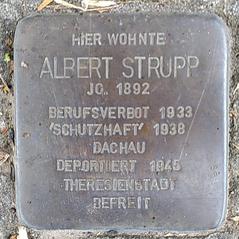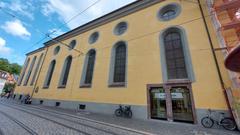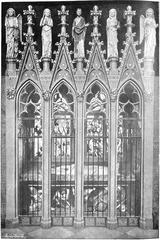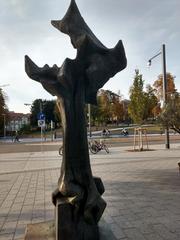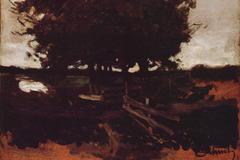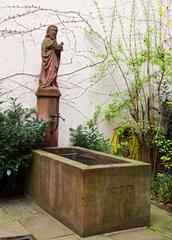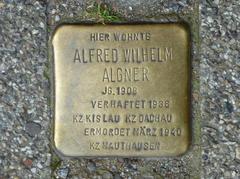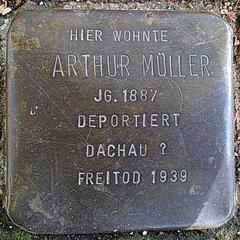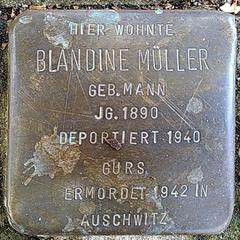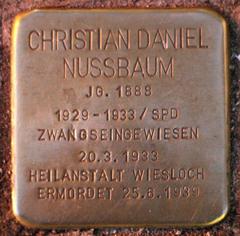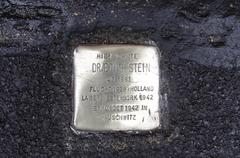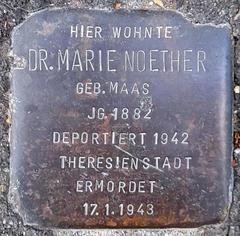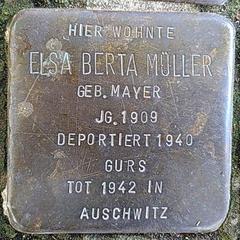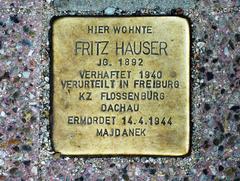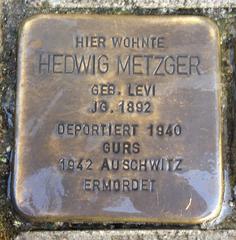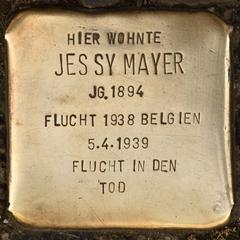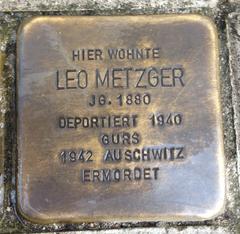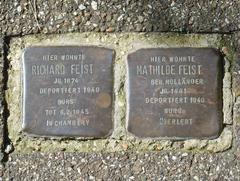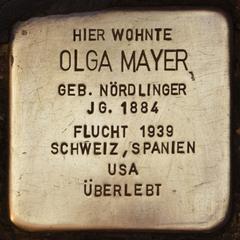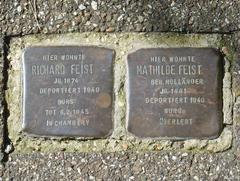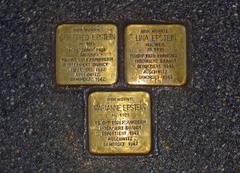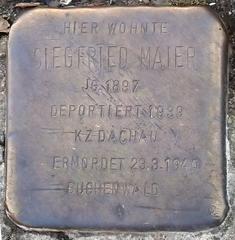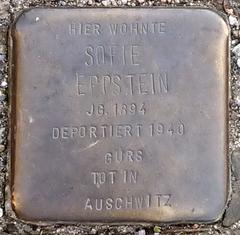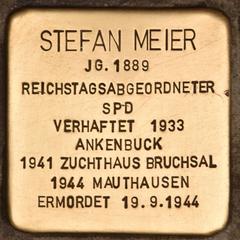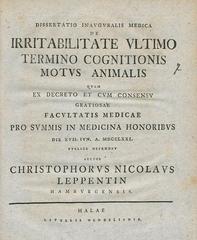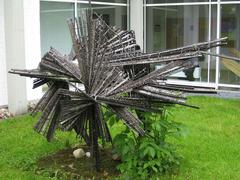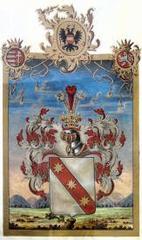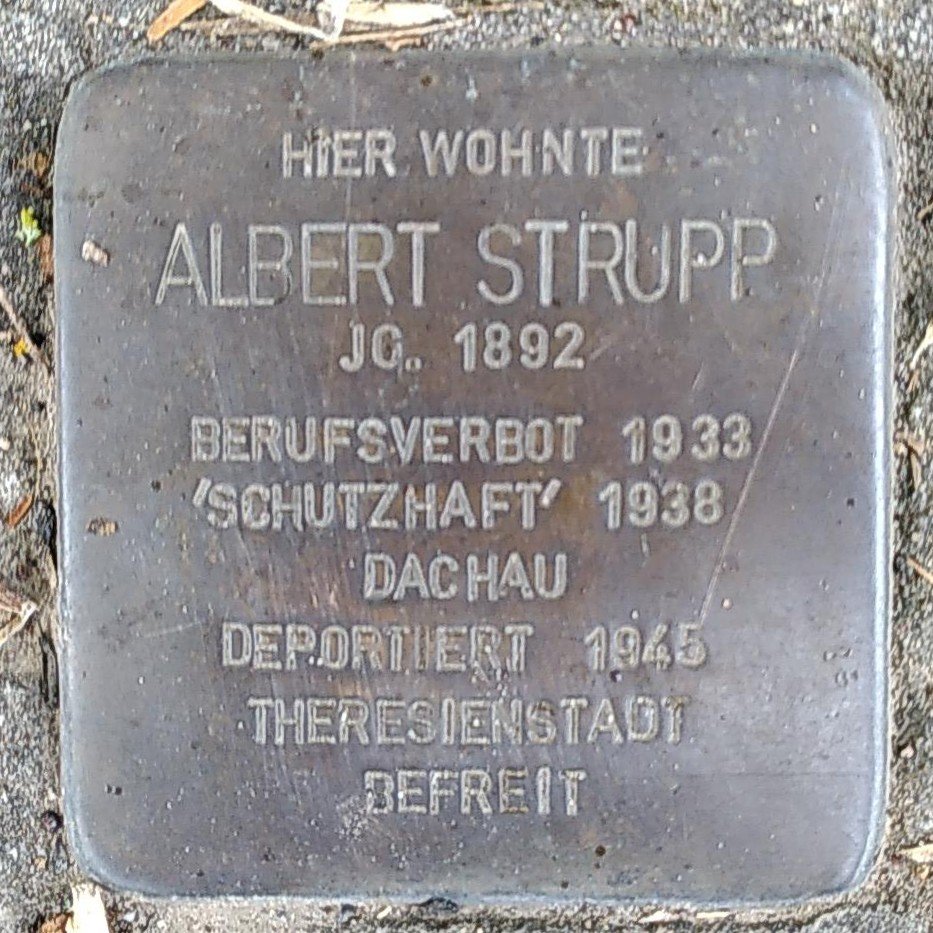
Stolperstein Albert Strupp Freiburg: Visiting Hours, Tickets, and Comprehensive Guide
Date: 14/06/2025
Introduction
The Stolpersteine dedicated to Albert Strupp in Freiburg im Breisgau, Germany, are powerful markers of remembrance for the victims of Nazi persecution. Initiated by artist Gunter Demnig in the early 1990s, these “stumbling stones” are small brass plaques embedded in sidewalks at the last freely chosen residence of individuals targeted by the National Socialist regime. Since 2002, Freiburg has actively participated in this decentralized memorial project, with over 480 Stolpersteine integrated throughout the city, making memory a tangible and accessible part of daily urban life (stolpersteine.eu, Germany.info).
Albert Strupp’s Stolperstein holds unique significance. Strupp, a Jewish lawyer, survived Nazi persecution and later contributed to postwar justice in Freiburg. His Stolperstein, located in the Zähringen district, invites both residents and visitors to reflect on personal stories embedded in public space. Complementary memorials, such as the Albert Strupp Memorial on Luisenstraße, and guided experiences—both in-person and digital—enhance understanding of Freiburg’s complex history (Stolpersteine in Freiburg, Freiburg Tourism, Stolpersteine Freiburg Initiative).
This guide offers detailed insight into the history, practical visiting information, respectful engagement, and further opportunities for exploration related to the Stolperstein for Albert Strupp in Freiburg.
Contents
- Origins and Development of the Stolpersteine Project in Freiburg
- Stolpersteine in Freiburg im Breisgau: A Local Memorial
- The Stolperstein Dedicated to Albert Strupp
- Visiting the Stolpersteine in Freiburg: Practical Information
- Community Engagement and Educational Impact
- Preserving Memory: Maintenance and Ongoing Work
- FAQ – Stolpersteine Freiburg Visitor Questions
- Albert Strupp Memorial in Freiburg: Visitor Information and Historical Significance
- Albert Strupp Stolperstein in Freiburg: Visiting Hours, Location & Tips
- Visiting Stolpersteine in Freiburg: History, Tours, and Visitor Guide
- Summary and Visitor Recommendations
- Sources and Further Reading
Origins and Development of the Stolpersteine Project in Freiburg
The Stolpersteine (“stumbling stones”) project was founded by Gunter Demnig in the early 1990s to commemorate victims of National Socialism. Each 10 x 10 cm concrete cube features a hand-engraved brass plate with the individual’s name, birth year, fate, and (if known) date and place of death. The stones are installed in front of the last freely chosen residences of the victims (stolpersteine.eu; Tablet Magazine).
Since 1992, the project has grown to over 116,000 stones across 1,860+ communities in 31 European countries, making it the world’s largest decentralized memorial (stolpersteine.eu). Unlike centralized Holocaust memorials, Stolpersteine integrate remembrance into daily life, inviting spontaneous encounters with history (Germany.info).
Stolpersteine in Freiburg im Breisgau: A Local Memorial
Freiburg’s involvement began in 2002 with the first stone for Professor Dr. Robert Liefmann at Goethestraße 33. The city now has nearly 500 Stolpersteine, commemorating individuals from diverse backgrounds, including Jews, Sinti and Roma, LGBTQ+ people, and political prisoners (Stolpersteine in Freiburg; Wikipedia). The stones are distributed across districts such as the Altstadt, Brühl, Ebnet, Günterstal, Haslach, Herdern, Lehen, Mooswald, Oberau, Sankt Georgen, Stühlinger, Waldsee, and Zähringen.
The Stolperstein Dedicated to Albert Strupp
Albert Strupp was the only Jewish lawyer admitted to the Landgericht Freiburg before World War II. Despite facing persecution, internment in Dachau, and deportation to Theresienstadt, he survived and later worked for justice in postwar Freiburg (Stolpersteine in Freiburg – Albert Strupp). His Stolperstein, situated in the Zähringen district, serves as a touchstone for memory and education, encouraging passersby to physically and metaphorically “lift” his story from obscurity (Folklife Magazine).
Visiting the Stolpersteine in Freiburg: Practical Information
Visiting Hours & Access:
Stolpersteine are in public sidewalks and accessible 24/7, free of charge.
Guided Tours:
Local organizations and the tourism office offer guided walking tours that delve into the history behind the stones. Check the Freiburg Tourism website for details.
Accessibility:
Most Stolpersteine are on wheelchair-accessible pedestrian routes, though some sidewalks may be uneven. Plan routes accordingly.
Tickets:
No tickets are needed; visits are always free.
Travel Tips:
Wear comfortable shoes and consider downloading the Audiala app for audio guides and interactive maps.
Map & Virtual Tour:
Interactive maps are available on the Stolpersteine in Freiburg website.
Community Engagement and Educational Impact
Freiburg’s Stolpersteine project is community-driven. Stones are sponsored by local residents, schools, and organizations (approximately €120 per stone), with students and historians researching biographies to personalize remembrance (Tablet Magazine). Ceremonies for new Stolpersteine often involve relatives, community groups, and sometimes Gunter Demnig himself, promoting dialogue and collective memory (stolpersteine.eu).
Preserving Memory: Maintenance and Ongoing Work
Maintenance of Stolpersteine is a shared responsibility; sponsors and local volunteers regularly clean and care for the stones (Folklife Magazine). Biographical data is digitally archived, and new stones are added each year in Freiburg (Stolpersteine in Freiburg).
FAQ – Stolpersteine Freiburg Visitor Questions
Are Stolpersteine free to visit?
Yes, they are accessible any time at no cost.
Are guided tours available?
Yes, via local organizations and the tourist office.
Is the route wheelchair accessible?
Most stones are on accessible paths, but some areas may be uneven.
Where can I learn more about individual victims?
The Stolpersteine in Freiburg website has detailed biographies.
Can I sponsor a Stolperstein?
Yes, contact local organizations to learn about sponsorship.
Albert Strupp Memorial in Freiburg: Visitor Information and Historical Significance
History and Significance
Located near Albert Strupp’s former residence on Luisenstraße in the Ettenheim district, the memorial commemorates his life and the broader experience of Freiburg’s Jewish community. Strupp’s survival and postwar work embody resilience and justice.
Visiting Information
- Location: Luisenstraße, Ettenheim district, Freiburg
- Hours: Daily, 9:00 AM–6:00 PM
- Admission: Free
- Guided Tours: Weekends at 11:00 AM and 3:00 PM (booking recommended)
Travel & Accessibility
Reachable via tram lines 1 or 3 to the Ettenheim stop, followed by a short walk. The site is wheelchair accessible.
Nearby Attractions
- Freiburg Historical Museum
- Jewish Cultural Center Freiburg
- Münsterplatz (Cathedral Square)
FAQs
- Is the memorial free? Yes.
- Are guided tours available? Yes, on weekends.
- Open year-round? Yes, daily 9:00 AM–6:00 PM.
- Suitable for children? Yes, though content may be best for older children.
Albert Strupp Stolperstein in Freiburg: Visiting Hours, Location & Tips
Exact Location
The Stolperstein for Albert Strupp is located in the Zähringen district, near Platz der Zähringer (Mapcarta), set in the pavement before his last freely chosen residence (Denkmalprojekt). Nearby is the Stolperstein for Liselott Strupp.
Accessibility and Directions
- Public Transport: Tram line 4 to “Zähringen,” then a short walk.
- By Bicycle/Foot: 10–40 minutes from city center.
- By Car: Limited parking; public transport recommended.
- Wheelchair Access: Pavements are generally accessible.
Practical Tips
- Best Time: Early morning or late afternoon for quiet reflection.
- Engagement: Pause, reflect, consider placing a small stone or flower, or gently clean the plaque.
- Nearby Attractions: Other Stolpersteine, “Herz auf Säule mit Ei” sculpture, Black Forest trails.
- Dining/Lodging: Numerous options in Zähringen and city center.
- Weather: Freiburg is mild; brass can be slippery when wet.
FAQs
- Specific hours? Always open.
- Tickets required? No.
- Guided tours? Yes, see Freiburg-Schwarzwald.de.
- Groups/school classes? Yes, suitable for all.
- Translations? Use translation apps or consult local guides.
Visiting Stolpersteine in Freiburg: History, Tours, and Visitor Guide
Stolpersteine are brass plates embedded at the last freely chosen residences or workplaces of Nazi victims (Stolpersteine Official). In Freiburg, these stones remember Jewish citizens and other persecuted groups, including Albert and Liselott Strupp at Jägerstraße 19.
Practical Information
- Hours: 24/7 access, no charge.
- Location: Jägerstraße 19, Freiburg.
- Accessibility: Wheelchair-friendly pavements.
- Guided Tours: Offered by Gedenkstätten Südlicher Oberrhein.
- Self-Guided: Use Stolperstein Database for maps and biographies.
Ethical Guidelines
- Pause quietly at the stone.
- Place a small stone or flower if you wish.
- Take respectful photos.
- Learn about the person commemorated.
- Engage with local remembrance events.
Educational Value
Albert Strupp’s story highlights survival through a “privileged mixed marriage,” his internment in Dachau, and postwar legal work. Focusing on individual stories fosters a deeper understanding of history and ongoing responsibility (Badische Zeitung Article, PDF).
Summary and Visitor Recommendations
Visiting the Albert Strupp Stolperstein in Freiburg is a deeply meaningful way to engage with Holocaust remembrance. The memorial’s accessibility, absence of entry fees, and integration into everyday urban space make it a unique and impactful experience. Complementary resources, such as guided tours, educational materials, and the Audiala app, provide further context and depth. Engaging respectfully—by pausing, cleaning the stone, or participating in local commemorative traditions—ensures the memory of individuals like Albert Strupp endures. Community involvement and ongoing maintenance highlight the living nature of remembrance in Freiburg.
Sources and Further Reading
- stolpersteine.eu
- Germany.info
- Stolpersteine in Freiburg
- Jüdisches Zentrum Freiburg
- Stolpersteine Freiburg Initiative
- Gedenkstätten Südlicher Oberrhein
- Tablet Magazine
- Folklife Magazine
- Denkmalprojekt
- Springer Link
- Badische Zeitung Article, PDF
- Freiburg Tourism
